Keywords
|
| Image fusion, BWT, multi-focus, multi-resolution, registration |
INTRODUCTION
|
| Image fusion is one of the important embranchments of data fusion. Its purpose is to synthesis multi-image information in one scene to one image which is more suitable to human vision and computer vision. Multiple images can be taken by the use of Visual Sensor Networks (VSN). It is a term used in literature to refer to a system with large number of cameras, geographically spread resources and many monitoring points. In VSN, sensors are cameras which can record either still images or video sequences. Therefore, the processing of output information is related to image processing and machine vision subjects. |
| In a visual sensor network a large number of camera nodes form a distributed system, where the camera nodes are able to process image data locally and to extract relevant information, to collaborate with other cameras on the application-specific task, and to provide the system’s user with information-rich descriptions of captured events. Image fusion is a process of combining multiple source images into a smaller set of images, usually one single image[1]. This single image generated is more accurate and has more information. Image fusion using DCT is easy and time saving in real time systems. In general most of the spatial domain techniques are complex and time consuming which are hard to be performed on real-time applications. But when the source images are coded in JPEG format then the fusion approaches which are applied in DCT domain will be very efficient. Principal component analysis is a mathematical tool which transforms a number of correlated variables into a several uncorrelated variables. PCA is widely used in image classification. The weights for each source image are obtained from the normalized Eigen vector of the covariance matrices of each source image. |
IMAGE FUSION TECHNIQUES
|
| Commonly applied fusion techniques have been described below: |
A. PRINCIPAL COMPONENT ANALYSIS
|
| Principal component analysis (PCA) is used to reduce dimensionality. It is a vector space transform. PCA involves ways for identifying and to show patterns in data, in such a way as to highlight their similarities and differences, and thus reduce dimension without loss of data[2]. This method first extracts the column vectors from respective input image matrices. The covariance matrix is calculated. Diagonal elements of covariance vector will contain variance of each column vector. The vector of covariance matrix and eigen values are calculated. Normalize column vector corresponding to larger Eigen value by dividing each element with mean of Eigen vector. Those normalized Eigen vector values act as the weight values and are multiplied with each pixel of input image. Sum of the two scaled matrices are calculated and it will be the fused image matrix[3]. |
| Let X is a d-dimensional random vector. This X has a zero empirical mean. V is the Projection Vector such that Y=VTX. Covariance of Y(cov(Y)) is diagonal. |
| V inverse is equivalent to its transpose(V-1=VT). Therefore by applying matrix algebra: |
 |
 |
 |
 |
| MuItiply both sides of equation (4) by V. The following will be obtained |
 |
| Substitute equation (4) into the equation (5). |
| We obtain: |
 |
| The following can thus be drawn from the above equations: |
 |
| where, i =1, 2, ... , d and Vi is an eigenvector of cov(X). |
| Normalized components P1 and P2 are calculated from the obtained eigenvector value. The fused image is computed by equation: |
 |
| The covariance matrix C of X i.e. C=XXT mean of expectation = cov(X). Then calculate the eigen-vectors V and eigenvalue D of C and sort them by decreasing eigen-value. Both V and D are of dimension 2 x 2. Consider the first column of V which corresponds to larger eigen-value to compute P1 and P2 as : |
 |
 |
B. DISCRETE COSINE TRANSFORM
|
| Discrete cosine transform (DCT) is a very important transform in image processing Large DCT coefficients are concentrated in the low frequency region; hence, it is known to have excellent energy compactness properties and edges may contribute high frequency coefficients[4]. |
| The 2-D cosine transform of an image block f(x,y) of size N x N is given by equations: |
 |
| where u, v = 0,1,....,N-1 and |
 |
| The inverse transform can be defined as: |
 |
| where x, y = 0,1, …, N-1. Here F(0,0) is the DC coefficient and it corresponds to the mean value of that image block. The remaining coefficients are AC coefficients. |
| The key step is to fuse the DCT representations of multi-focus images into a single fused image. The input images are divided into blocks of size 8x8 and the DCT coefficients of each block is computed. Then the fusion rule is applied. |
C. BIORTHOGONAL WAVELET TRANSFORM
|
| The most common form of transform type image fusion algorithms is the wavelet fusion algorithm due to its simplicity and its ability to preserve the time and frequency details of the images to be fused [5][6]. In common with all transform-domain fusion techniques, the transformed images are combined in the wavelet domain using a predefined fusion rule, then transformed back to the spatial domain to give the resulting fused image. Wavelet transform fusion is more formally defined by considering the wavelet transforms w of the two registered input images I1 (x, y) and I2 (x, y) together with the fusion rule μ . Then, the inverse wavelet transform w-1 is computed, and the fused image I (x, y) is reconstructed: |
 |
| Image fusion is the process of generating a single fused image that contains a more accurate description of the scene than multiple images from different sources. Image fusion techniques have been developed for fusing the complementary information of multisource input images in order to create a new image that is more suitable for human visual or machine perception. The way the sources combine their information depends upon the nature of images and the way they have been acquired. Images can be fused in spatial domain or in other transformed domains. Several image fusion techniques are present in literature. Haghighat et al. has studied that the objective of vision fusion is to merge information from many images of the same view in order to deliver only the useful information[7]. The Biorthogonal cosine transform based techniques of vision fusion are more suitable and time-saving in real-time systems using Biorthogonal cosine transform based values of still image or video. He conducted the experiments which evaluates the fusion performance and the results show that the proposed method outperforms the previous DCT based techniques both in quality and complexity reduction. This method is used mostly when the image is in jpeg format. A shortcoming of this method is that it is a bit weak on the boundaries between focused and out of focus areas. Lui et al. (2010) has discussed that vision fusion is a very main step for vision mosaic. Fusion algorithms affect the visual effect and quality of the mosaic imagery directly. An adaptive weighted coefficients algorithm for vision fusion has been proposed. Adaptive weighted coefficients algorithm can adjust weighted coefficients adaptively along with changes of the variety and shape of the overlapping regions. Harris operator is used to sense feature points. Pei et al. has discussed that improved Biorthogonal wavelet based vision fusion algorithm, after studying the principles and characteristics of the Biorthogonal wavelet framework. These algorithms can efficiently mixture the useful information of the each source vision retrieved from the multi sensor. It can mixture the two or more images into one image which is more accurate and reliable. Tao et al. has proposed medical vision fusion has very important value of application for medical image analysis and diagnosis. The traditional way of wavelet fusion is improved and a new algorithm of medical vision fusion is presented. When choosing high frequency coefficients, the regional edge intensities of each sub-vision are calculated to realize adaptive fusion. The low frequency coefficient choosing is based on edges of images, so that the fused vision can preserve all useful information and appears clearly. Traditional and improved fusion algorithms based on wavelet transform to combine images and also evaluate the combination results has been applied. Patil et al. has proposed vision fusion algorithm using hierarchical PCA. Vision fusion is a process of combining two or more images which are registered. Principal component analysis (PCA)[8] is a well-known scheme for feature extraction and dimension reduction and is used for vision fusion. PCA is a mathematical tool which transforms a number of correlated variables into a several uncorrelated variables. The author has proposed the image fusion algorithm combining pyramid and PCA technique. Qualitative and quantitative analysis of these fused algorithms were carried out. Experts opined that multimodal fused image using hierarchical PCA algorithm is more informative than fused image using individual pyramid or PCA algorithm. Albuquerque et al. has discussed that vision focus is a property closely related to vision quality. In some images it is not possible to get a clear focus in a all regions simultaneously, so an alternative is to use picture fusion to merge images with different focus into one with all the best focused regions. There are two vision fusion algorithms in the frequency domain that are based on focus- DCT and spatial frequency. The algorithms divide the picture into fixed size of blocks to decide which picture should be selected to constitute the final result. Prakash et al. has proposed a pixel-level image fusion scheme using multiresolution Biorthogonal wavelet transform (BWT). Wavelet coefficients at different decomposion levels are fused using absolute maximum fusion rule. Two important properties wavelet symmetry and linear phase of BWT[9][10] have been exploited for image fusion because they are capable to preserve edge information and hence reducing the distortions in the fused image. The performance of the proposed method have been extensively tested on several pairs of multifocus and multimodal images both free from any noise and in presence of additive white Gaussian noise and compared visually and quantitatively against existing spatial domain techniques. Experimental results have shown that the proposed method has improved fusion quality by reducing loss of significant information available in individual images. |
GAPS IN LITERATURE
|
| By conducting the review it has been found that the most of the existing literature has neglected at least one of the following: |
| • It may results in some color artifacts which may reduce the performance of the transform based vision fusion techniques. |
| • It is also found that the problem of the uneven illuminate has also been neglected in the most of existing work on fusion. |
| • The use of the filtering has also been neglected to reduce the noise which may be in the output image due to transform domain techniques or during capturing time. |
EXPERIMENTAL SETUP & RESULTS
|
| In order to implement PCA, DCT and BWT, design and implementation is done in MATLAB using image processing toolbox. Table 1 has shown the various images that has been taken in this research work for experimental purpose. |
•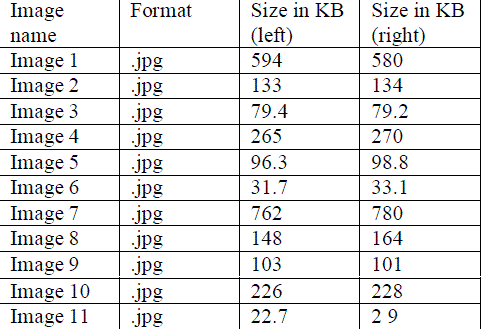 •Table 1: Input image •Table 1: Input image |
| Figure 1 has shown the input images for experimental analysis. Figure (a) is showing the left blurred image and figure. 2 (b) is showing the right blurred image. The overall objective is to combine relevant information from multiple images into a single image that is more informative and suitable for both visual perception and further computer processing. |
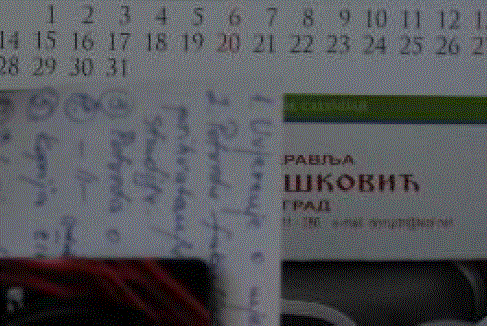
Figure 1(a): Left blurred image |
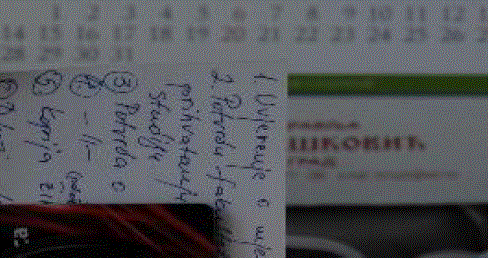
Figure 1(b): Right blurred image |
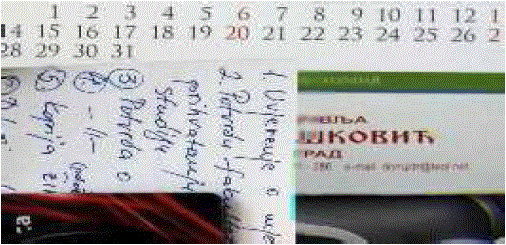
Figure 2: BWT based image fusion |
| Figure 2 has shown the output image taken by BWT. The output image preserves the brightness of original blurred images to be fused but color is imbalanced which have degraded the quality of the image. |
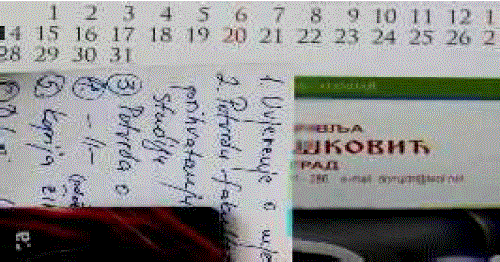
Figure 3: DCT based image fusion |
| Figure 3 has shown the output image taken by DCT. The output image has contained too much brightness and color imbalance as compare to original blurred images to be fused. |
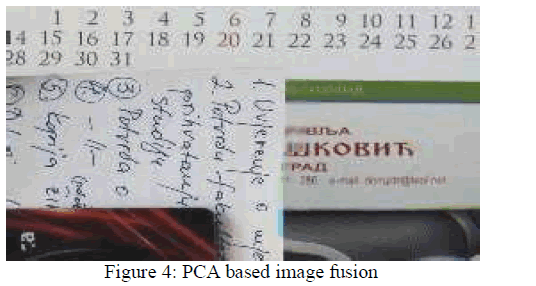 |
| Figure 4 has shown the output image taken by PCA. The output image has contained low brightness and low contrast as compare to original blurred images to be fused which have degraded the quality of the image. |
PERFORMANCE ANALYSIS
|
| This section contains the comparative analysis between DCT, PCA and BWT based images fusion. Different image fusion metrics has been considered to find the best algorithm among the available algorithms. |
| Table 2 and figure 5 has the comparative analysis of API between three techniques. It has been clearly shown that among the available techniques DCT based fusion shows more significant results over the PCA and BWT. |
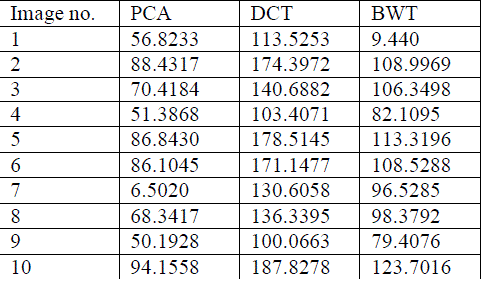
Table 2: Average Picture Intensity (API) evaluation |
| Table 3 and figure 6 has the comparative analysis of standard deviation between three techniques. It has been clearly shown that among the available techniques DCT based fusion shows more significant results over the PCA and BWT as in all cases the standard deviation of DCT based technique is more than other techniques. |
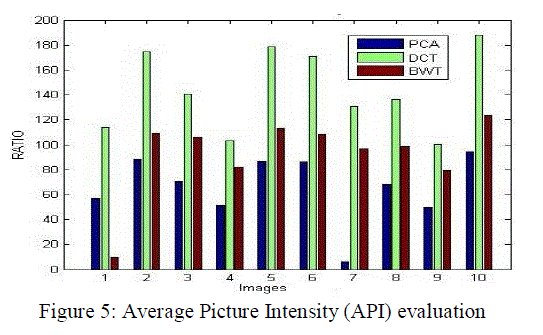 |
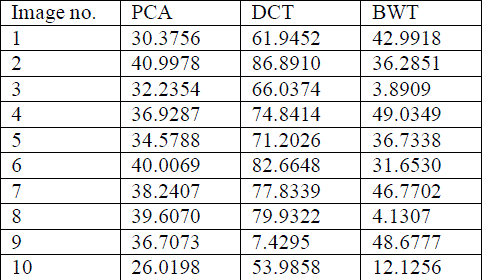
Table 3: Standard deviation evaluation |
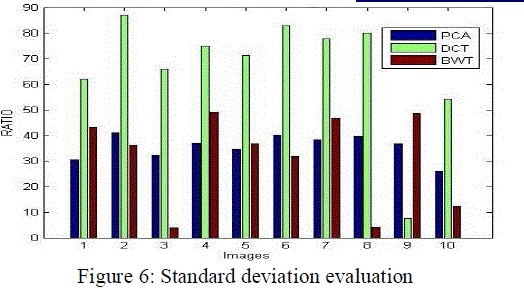 |
| Table 4 and figure 7 has the comparative analysis of Fusion Factor between three techniques. It has been clearly shown that among the available techniques DCT based fusion shows more significant results over the PCA and BWT as in all cases the Fusion Factor of DCT based technique is more than other techniques. |
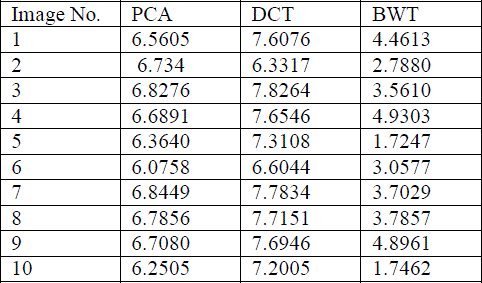
Table 4: Fusion Factor |
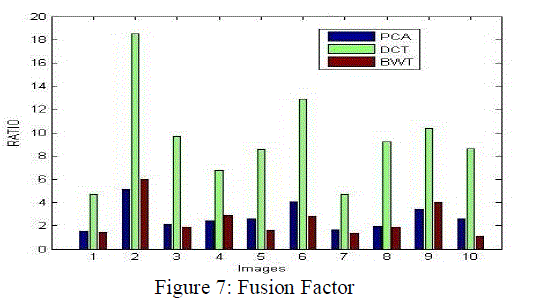 |
| Table 5 and figure 8 has the comparative analysis of Measured Entropy between three techniques. It has been clearly shown that among the available techniques DCT based fusion shows more significant results over the PCA and BWT as in all cases the Measured Entropy of DCT based technique is more than other techniques. |
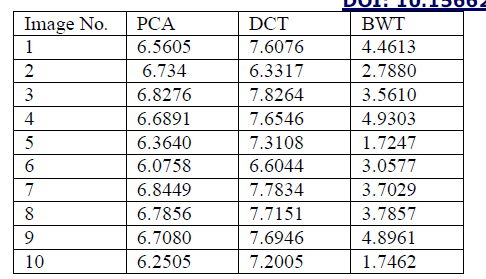 |
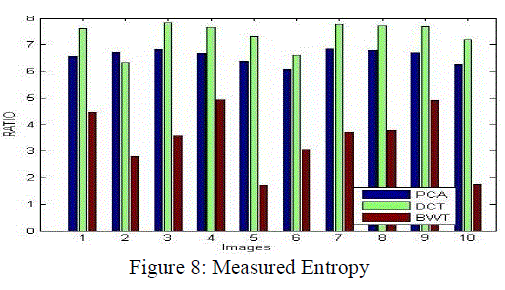 |
CONCLUSION & FUTURE WORK
|
| Out of various image fusion methods known today,DCT is considered to be more appropriate and time-saving in real-time systems among DCT, PCA and BWT. In this paper performance evaluation based on DCT,PCA and BWT image fusion techniques. The comparative analysis has shown the DCT based image fusion has significant results over the available algorithms i.e. BWT and PCA. In near future this work can be extended to use guided filters to enhance the BWT base fusion in more efficient manner. |
References
|
- O. Perez, M. A. Patricio. J. Garcia, J. Carbo, and J. M. Molina,“Fusion of Surveillance Information for Visual Sensor Networks,” Proceedings of theIEEE Ninth International Conference on Information Fusion.
- Anima Mishra and Subrata Rakshit. Fusion of noisy multi-sensor imagerys. Defense Science Journal, 58:136–146, 2008.
- Wang Zhong-hua, Qin Zheng, and Liu Yu. A framework of region based dynamic image fusion. Journal of Zhejiang University ISSN 1009-3095,pages 56–62, August 2007.
- Mohammad BagherAkbariHaghighat, Ali Aghagolzadeh, and HaldiSeyedarabi, “Real-Time Fusion of Multi-Focus Images for Visual SensorNetworks”,IEEE 2010.
- H. H. Wang, “A new multiwavelet-based approach to image fusion”,Journal of Mathematical Imaging and Vision, vol.21, pp.177-192, 2004.
- R. Singh, R. Srivastava, O. Prakash and A. Khare, "DTCWT based multimodal medical image fusion", in proc. of International conference onSignal, Image and Video processing, January 2012, pp. 403-407, IIT Patna.
- J. Tang, “A contrast based image fusion technique in the DCT domain,”Digital Signal Processing, vol. 14,no. 3, pp. 218 – 226, 2004.
- P J. Burt and E H. Adelson. The laplacian pyramid as a compact image alignment by maximization of mutual information. Proc. of the 5thInternational Conference on Computer vision, 31:1–5, 2008.
- G. Piella, “A general framework for multiresolution image fusion: from pixels to regions, Information Fusion,” Vol. 4, No. 4, pp. 259-280,2003.
- N. Mitianoudis, T. Stathaki, “Pixel-based and Region-based Image Fusion schemes using ICA bases,” Special Issue on Image Fusion:sAdvances in the State of the Art, Vol. 8, No. 2, pp. 131-142, 2007.
|